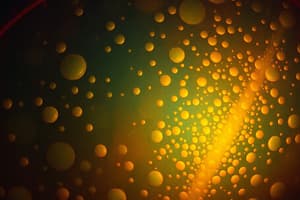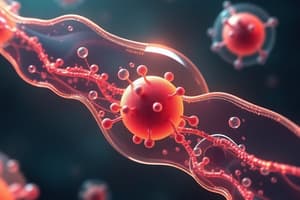Podcast
Questions and Answers
What is the primary characteristic of tight junctions?
What is the primary characteristic of tight junctions?
- Forms a selective barrier between adjacent cells (correct)
- Generates electrical charges across membranes
- Involves extensive communication between cells
- Allows for high permeability of substances
Which proteins are primarily involved in the adhesion of tight junctions?
Which proteins are primarily involved in the adhesion of tight junctions?
- Caveolins
- Cadherins
- Intrinsic membrane proteins (correct)
- Integrins
What type of junction is found near the apical pole of epithelial cells?
What type of junction is found near the apical pole of epithelial cells?
- Gap junction
- Tight junction (correct)
- Desmosome
- Adherens junction
During which stage of development do junctions typically form?
During which stage of development do junctions typically form?
Which of the following junction types is characterized by a filamentous structure anchoring cells together?
Which of the following junction types is characterized by a filamentous structure anchoring cells together?
What is the main function of junctions in epithelial tissues?
What is the main function of junctions in epithelial tissues?
Caveolae, a specialized type of lipid raft, play a role in which cellular process?
Caveolae, a specialized type of lipid raft, play a role in which cellular process?
What is a consequence of compromised junction types in tissues?
What is a consequence of compromised junction types in tissues?
What is the primary function of intermediate junctions in tissues?
What is the primary function of intermediate junctions in tissues?
What is another name for intermediate junctions?
What is another name for intermediate junctions?
Which unique structural feature differentiates spot desmosomes from intermediate junctions?
Which unique structural feature differentiates spot desmosomes from intermediate junctions?
What is the role of cadherins in intermediate junctions?
What is the role of cadherins in intermediate junctions?
What is the intercellular space between the plasma membranes in intermediate junctions?
What is the intercellular space between the plasma membranes in intermediate junctions?
Which statement about cadherin interaction is true?
Which statement about cadherin interaction is true?
What component connects cadherins to actin filaments in the cytoplasmic face of intermediate junctions?
What component connects cadherins to actin filaments in the cytoplasmic face of intermediate junctions?
In what type of tissues are intermediate junctions particularly prevalent?
In what type of tissues are intermediate junctions particularly prevalent?
What role do tight junctions play in the epithelium of the intestine?
What role do tight junctions play in the epithelium of the intestine?
What serves as the main structural component of tight junctions?
What serves as the main structural component of tight junctions?
How do tight junctions contribute to cell shape determination?
How do tight junctions contribute to cell shape determination?
What is the primary function of the belt formed by tight junctions?
What is the primary function of the belt formed by tight junctions?
In which tissues can tight junctions be primarily found?
In which tissues can tight junctions be primarily found?
What is a characteristic feature of the arrangement of tight junctions?
What is a characteristic feature of the arrangement of tight junctions?
What must nutrients do to be absorbed by epithelia, considering tight junctions' role?
What must nutrients do to be absorbed by epithelia, considering tight junctions' role?
What is one of the critical controlling factors of tight junction formation?
What is one of the critical controlling factors of tight junction formation?
Flashcards
Tight Junction
Tight Junction
A type of cell junction that forms a tight seal between adjacent epithelial cells, preventing the passage of fluids and molecules between them.
Occludin
Occludin
A transmembrane protein that forms the core of tight junctions, acting like the teeth of a zipper.
Actin Filament and Tight Junctions
Actin Filament and Tight Junctions
Actin filaments, a type of cytoskeletal fiber, attach indirectly to occludin, contributing to cell shape and stability.
Tight Junction Belt
Tight Junction Belt
Signup and view all the flashcards
Tight Junctions and Nutrient Absorption
Tight Junctions and Nutrient Absorption
Signup and view all the flashcards
Locations of Tight Junctions
Locations of Tight Junctions
Signup and view all the flashcards
Regulation of Tight Junctions
Regulation of Tight Junctions
Signup and view all the flashcards
Tight Junctions and Apical Membrane Permeability
Tight Junctions and Apical Membrane Permeability
Signup and view all the flashcards
Lipid Rafts (Microdomains)
Lipid Rafts (Microdomains)
Signup and view all the flashcards
Caveolae
Caveolae
Signup and view all the flashcards
Tight Junctions (Zonula Occludens)
Tight Junctions (Zonula Occludens)
Signup and view all the flashcards
Desmosomes
Desmosomes
Signup and view all the flashcards
Cell Adhesion Molecules (CAMs)
Cell Adhesion Molecules (CAMs)
Signup and view all the flashcards
Intermediate Junctions
Intermediate Junctions
Signup and view all the flashcards
Junction Formation
Junction Formation
Signup and view all the flashcards
Intercellular Communication
Intercellular Communication
Signup and view all the flashcards
Spot Desmosomes
Spot Desmosomes
Signup and view all the flashcards
Cadherins
Cadherins
Signup and view all the flashcards
Catenins
Catenins
Signup and view all the flashcards
Actin Filaments in Intermediate Junctions
Actin Filaments in Intermediate Junctions
Signup and view all the flashcards
Intercellular Space in Intermediate Junctions
Intercellular Space in Intermediate Junctions
Signup and view all the flashcards
Basal Pole
Basal Pole
Signup and view all the flashcards
Hemidesmosomes
Hemidesmosomes
Signup and view all the flashcards
Study Notes
Plasma Membranes and Other Cell Membranes
- Membranes are found in all cells, including the plasma membrane, nuclear membranes, endoplasmic reticulum membranes, Golgi apparatus membranes, vacuole membranes, plastid membranes, and mitochondrial membranes.
- These membranes (called cytomembranes) form compartments within the cell, separating them from their surroundings.
- Prokaryotic cells have simpler membranes than eukaryotic cells, which have more complex compartmentalization.
- The plasma membrane, also called the plasmalemma or cytoplasmic membrane, is crucial for cell integrity by separating the cytoplasm from the surrounding environment.
- Damage to the plasma membrane can lead to cell death.
- Cell membranes are involved in many biochemical reactions, such as signal transduction, phosphorylation, and cell respiration (in prokaryotes).
- They also facilitate communication and interaction between neighboring cells.
- Cell membranes have selective permeability, regulating the passage of substances between compartments.
- Some molecules readily pass through the lipid bilayer (hydrophobic), while others need channels or transporters (hydrophilic).
- Passage can be active or passive.
The Lipid Bilayer
- Cell membranes primarily consist of a phospholipid bilayer.
- Phospholipids are amphipathic, meaning they have both polar (hydrophilic) heads and nonpolar (hydrophobic) tails.
- They arrange in a bilayer to minimize contact between hydrophobic tails and water.
- Proteins and carbohydrates are also components of cell membranes.
- The proportions of these components vary between different cell types.
- Different proteins have different functions, including transport, signaling, and structure.
The Fluid-Mosaic Model
- The fluid-mosaic model describes the structure of cell membranes.
- The model depicts a phospholipid bilayer with embedded proteins.
- Protein types include peripheral (extrinsic) proteins, loosely bound to the membrane's surface, and integral (intrinsic) proteins, firmly embedded within the bilayer.
- Integral proteins can span the membrane entirely (transmembrane) or only partly.
- Carbohydrates are typically attached to proteins (glycoproteins) or lipids (glycolipids) on the outer surface.
Membrane Asymmetry
- Proteins and lipids are not distributed evenly across the membrane layers (inner and outer leaflets).
- Different types of lipids and proteins are more prevalent in one leaflet than the other.
- This asymmetry is crucial for the function of the cell membrane.
Membrane Fluidity
- Membranes are dynamic, their components are in constant motion within the bilayer.
- Factors influencing fluidity include temperature, fatty acid saturation, and the presence of cholesterol.
- Cholesterol acts as a regulator, decreasing fluidity at high temperatures and increasing it at low temperatures.
- Membrane fluidity is essential for proper function.
Membrane Specializations
- Cell membranes exhibit specialized domains, with variations in protein and lipid compositions.
- Junctions like tight junctions, intermediate junctions (desmosomes), and gap junctions facilitate cell-cell interactions.
- Gap junctions allow communication and the movement of molecules between cells.
- Microvilli and stereocilia increase surface area for absorption or secretion.
- Infolds of the basal membrane enhance absorption or secretion (e.g., in kidney cells).
Specialization of the plasma membrane
- Junctions facilitate cell-cell adhesion, communication, and transport.
- Junctions include tight, gap, and desmosomes, all with unique functions.
Transport of Macromolecules
- Larger molecules use bulk transport (endocytosis and exocytosis) which is a process involving vesicles.
- Endocytosis (inward movement) includes phagocytosis (for large particles) and other types of endocytosis for other molecules.
- Exocytosis (outward movement) releases molecules out of the cell.
- Both processes are essential for maintaining the integrity and function of the membrane.
Plant Cell Walls and Plasmodesmata
- Plant cells have cell walls, aiding structural support and protection.
- Plasmodesmata are channels in the cell wall permitting communication between neighboring cells.
- This structure differs from the animal cell counterparts in having a rigid cell wall.
- The channels enable the transport of water, ions, and small molecules between cells.
Microvilli
- Microvilli increase surface area in parts of cells where absorption or secretion need enhancing.
- The structure includes bundles of actin filaments providing support and possibly movement.
Studying That Suits You
Use AI to generate personalized quizzes and flashcards to suit your learning preferences.




